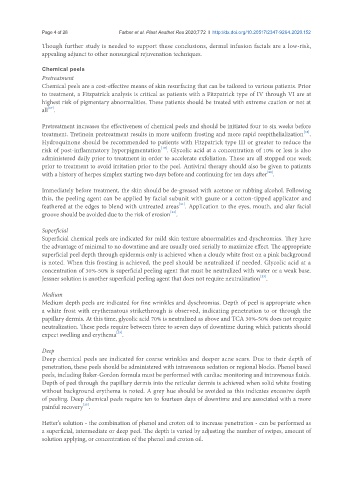Page 854 - Read Online
P. 854
Page 4 of 28 Farber et al. Plast Aesthet Res 2020;7:72 I http://dx.doi.org/10.20517/2347-9264.2020.152
Though further study is needed to support these conclusions, dermal infusion facials are a low-risk,
appealing adjunct to other nonsurgical rejuvenation techniques.
Chemical peels
Pretreatment
Chemical peels are a cost-effective means of skin resurfacing that can be tailored to various patients. Prior
to treatment, a Fitzpatrick analysis is critical as patients with a Fitzpatrick type of IV through VI are at
highest risk of pigmentary abnormalities. These patients should be treated with extreme caution or not at
[17]
all .
Pretreatment increases the effectiveness of chemical peels and should be initiated four to six weeks before
[18]
treatment. Tretinoin pretreatment results in more uniform frosting and more rapid reepithelialization .
Hydroquinone should be recommended to patients with Fitzpatrick type III or greater to reduce the
[19]
risk of post-inflammatory hyperpigmentation . Glycolic acid at a concentration of 10% or less is also
administered daily prior to treatment in order to accelerate exfoliation. These are all stopped one week
prior to treatment to avoid irritation prior to the peel. Antiviral therapy should also be given to patients
[20]
with a history of herpes simplex starting two days before and continuing for ten days after .
Immediately before treatment, the skin should be de-greased with acetone or rubbing alcohol. Following
this, the peeling agent can be applied by facial subunit with gauze or a cotton-tipped applicator and
[21]
feathered at the edges to blend with untreated areas . Application to the eyes, mouth, and alar facial
groove should be avoided due to the risk of erosion .
[22]
Superficial
Superficial chemical peels are indicated for mild skin texture abnormalities and dyschromias. They have
the advantage of minimal to no downtime and are usually used serially to maximize effect. The appropriate
superficial peel depth through epidermis only is achieved when a cloudy white frost on a pink background
is noted. When this frosting is achieved, the peel should be neutralized if needed. Glycolic acid at a
concentration of 30%-50% is superficial peeling agent that must be neutralized with water or a weak base.
[23]
Jessner solution is another superficial peeling agent that does not require neutralization .
Medium
Medium depth peels are indicated for fine wrinkles and dyschromias. Depth of peel is appropriate when
a white frost with erythematous strikethrough is observed, indicating penetration to or through the
papillary dermis. At this time, glycolic acid 70% is neutralized as above and TCA 30%-50% does not require
neutralization. These peels require between three to seven days of downtime during which patients should
[23]
expect swelling and erythema .
Deep
Deep chemical peels are indicated for coarse wrinkles and deeper acne scars. Due to their depth of
penetration, these peels should be administered with intravenous sedation or regional blocks. Phenol based
peels, including Baker-Gordon formula must be performed with cardiac monitoring and intravenous fluids.
Depth of peel through the papillary dermis into the reticular dermis is achieved when solid white frosting
without background erythema is noted. A grey hue should be avoided as this indicates excessive depth
of peeling. Deep chemical peels require ten to fourteen days of downtime and are associated with a more
painful recovery .
[23]
Hetter’s solution - the combination of phenol and croton oil to increase penetration - can be performed as
a superficial, intermediate or deep peel. The depth is varied by adjusting the number of swipes, amount of
solution applying, or concentration of the phenol and croton oil.

